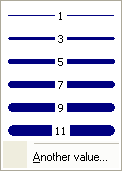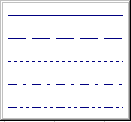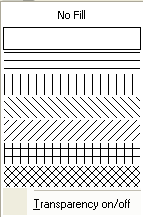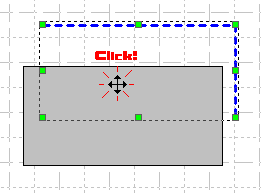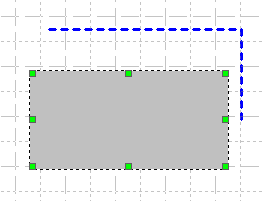Working with Objects, Editing Network Diagram
![]() Changing color, pattern, shading
Changing color, pattern, shading
![]() Copying to clipboard and pasting objects
Copying to clipboard and pasting objects
![]() Undoing and redoing last actions
Undoing and redoing last actions
To add an object to a diagram:
1. Open the necessary object category on the objects pane.
2. Select the required object.
3. Drag the object to the workspace.
The object on the diagram will appear at the position where it has been dropped.
All the commands for changing parameters of object texts are available on the toolbar.
Editing text
To edit the textual part of an object:
1. Select the object on a diagram.
2. Double-click on the object to activate the text editing mode.
3. Make the necessary changes in the mini-editor that appears.
4. Click on the same object or on a blank spot of the workspace.
When editing text, you can insert line feeds by pressing the Enter key. The entry field will be resized automatically.
Changing text font
To change a text font:
1. Select the object on a diagram.
2. Select the desired font on the
list on the toolbar.
When selecting a font for labeling diagonal lines, please keep in mind that not all the fonts can be displayed at an angle.
Changing font size
To change a font size:
1. Select the object on a diagram.
2. Select the desired font size on the
list on the toolbar.
You can also enter a custom font size in this field.
Changing text color
To change a text color:
1. Select the object on a diagram.
2. Select the desired text color on the
list on the toolbar.
You can also set any other color that is not available on the list; simply select Custom... on the list.
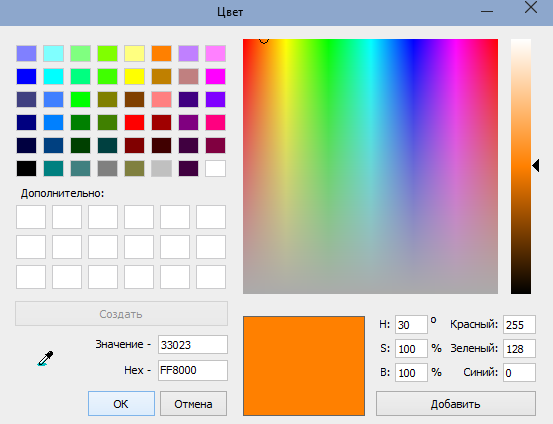
In the color selection dialog, select the desired color and then click OK.
Changing text style
To change a font style:
1. Select the object on a diagram.
2. On the toolbar, click on the
buttons to set the desired style: B - bold, I - italic, U - underlined. You can use any combinations of the styles.
Aligning text
The text part of an object can be aligned both vertically and horizontally. To align a text:
1. Select the object on a diagram.
2. On the toolbar, click one of these buttons
to align the text horizontally or one of these
to align it vertically.
Changing line width
This command is applicable only to objects of the Line type. To set a line width:
1. Select the line object on a diagram.
2. Click on the arrow area of the
button on the toolbar.
3. Select the desired width on the menu that appears.
You can set any other line width by selecting Other... on the menu and then entering the desired width in the Value field.
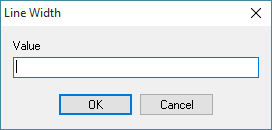
Changing line pattern
This command is applicable only to objects of the Line type. To set a line pattern:
1. Select the line object on a diagram.
2. Click on the arrow area of the
button on the toolbar.
3. Select the desired line pattern on the menu that appears.
Changing fill pattern
This command is applicable only to objects of the Area type. To set a fill pattern:
1. Select the area object on a diagram.
2. Click on the arrow area of the
button on the toolbar.
3. Select the desired fill pattern on the menu that appears.
You can make the area completely transparent by selecting the No fill value.
To fill an area with a color while keeping it transparent, select the Transparency On/Off on the menu. However, please keep in mind that not any color allows an area to be transparent.
Changing fill color
To change a fill color (line color):
1. Select the object on a diagram.
2. Select the desired color on the
list on the toolbar.
You can also set any other color that is not available on the list; simply select Custom... on the list.
You can view or edit the object's properties on the Object Properties window. To bring up the window, select an object and select Properties... in the context menu.
The application allows connecting with lines only objects of the Device type. There are three ways to connect two diagram objects with a line:
Method 1:
1. Enable the line drawing mode by selecting the main or context menu item "Line Drawing Mode". The program will lock the device layer so you will not be able to move or resize anything.
2. Place the mouse cursor on a device. Click the left mouse button and move the cursor to another device to be connected together.
3. Release the left mouse button to create a line.
4. To disable the line drawing mode, select the main or context menu item "Line Drawing Mode" again.
Method 2:
1. Place a line object on a diagram.
2. Select the line, move the mouse pointer to one of the corners of the line region. The pointer should now change to
.
3. Grab the corner (hold the left mouse button pressed); the square dot underneath the pointer should change its color to red.
4. Move the mouse pointer to the device object and then release the left mouse button.
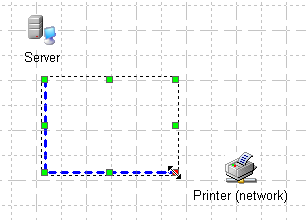
5. Move the mouse pointer to the other object and do the same with the opposite corner of the line region.
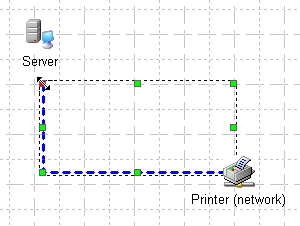
Method 3:
1. Place a line object on a diagram.
2. Drag the objects to the ends of the line.
3. Click on the line region. The devices are now connected.

To disconnect two objects, simply drag the line away from the devices.
To move an object over the workspace:
1. Select one or several objects (use the Shift key to select multiple objects or select the area with the objects using the mouse pointer).
2. Place the pointer over one of the selected objects and then click on it.
3. Hold the left mouse button pressed and move the mouse in the direction required. The objects will be moved along with the pointer.
4. Release the left mouse button.
To deselect objects, simply click on a blank spot of the workspace.
For more precise object placement on the diagram, you can use the object alignment function. You can align objects horizontally (by left or right side, by center, on equal distance), vertically (by top or bottom, etc.), in table (in rows and columns), and in circle. The circle alignment is useful when you want to align object around their common center (for example, computers around hub, switch, or server). If a circle radius is not large but there are a lot of devices, they can be placed in two circles to avoid icon overlapping.
To arrange a set of objects on the workspace:
1. Select one or several objects (hold the Shift key to select multiple objects or select the area with the objects using the mouse pointer).
2. Place the mouse pointer over one of the selected objects and make a right-click on it to display the context menu. Select the Align... menu item.
3. Select an arrangement method on the dialog window.
4. Click OK.
The application allows resizing objects of all types freely. To resize an object:
1. Select the object to be resized.
2. Move the mouse pointer to one of the green square dots of the object selection area. The pointer will change its look to one of these:



.
3. While holding the left mouse button pressed, move the mouse in the direction required. The objects will resize automatically.
4. Release the left mouse button.
![]() Copying to clipboard and pasting objects
Copying to clipboard and pasting objects
To copy objects to clipboard for further pasting them to the same or other Network Diagram document:
1. Select the objects to be copied.
2. Open the context menu for the selected objects and then select Copy (or press Ctrl + C).
3. Open the context menu over a blank spot of the workspace in this or another document, open and then select Paste (or press Ctrl + V). The object or the group of objects will be replicated.
To have the source object deleted upon pasting (moving the object), select Cut (or press Ctrl + X ) instead selecting Copy.
To copy an object or a group of objects to the clipboard for further pasting them to a Microsoft Office or other document, copy them as Windows Metafile. For that purpose:
1. Select the objects to be copied.
2. Open the context menu for the selected objects and then select the Copy as Windows Metafile item on the menu.
3. Switch to the other application window and paste the content from the clipboard to it.
![]() Undoing and redoing last actions
Undoing and redoing last actions
The application keeps track of the infinite number of last actions performed over objects. To undo the last action, select the Edit | Undo item on the main menu. To redo the undone action, select the Edit | Redo item on the main menu.
Objects on a diagram can overlap one another. By default, when a Device object is added on a diagram, it is placed on top of all other objects. However, you may need to change the order of placement for the overlapping objects. For that purpose:
1. On the diagram, select the object to be removed from the topmost layer.
2. Open the context menu and then select the Send to Back item. The object that was behind the object you have just moved will automatically be placed at the very front.
Similarly, you can move an object the other way, from the back to the front, by selecting its edge not overlapped by other objects and then clicking on the Send to Front menu item. These actions can be performed over several objects simultaneously, selecting each one of them while holding the Shift key down.
You can quickly swap two overlapping objects bypassing the context menu. For that purpose:
1. Click once to select the object that is currently in the front.
2. Clicking on the same object the second time on the area where it overlaps other object, will send it to back.
To search for an object (device, line, area) on the network diagram:
1. Select the Edit | Find on map... menu item.
2. On the Find text dialog window, select a search area and type the text to search in object names, descriptions, and host addresses.
3. Click OK.
The found objects will be enclosed with a frame and the program will scroll the diagram so the objects will become visible. Use the Case sensitive and Whole words only options for more exact searching.
To delete an object or a group of objects:
1. Select the object or a group of objects to be deleted.
2. Open the context menu for the selected objects and then select the Delete item or simply press the Del key on the keyboard.
You can lock the line and area layers for more comfortable map editing (moving objects, editing properties). This helps to avoid moving lines and areas when you are working with map objects. A group of objects can be selected and moved much easier when the layers are locked.
To lock the line or area layer, select the main menu item Lock line layer or Lock area layer. After doing this, lines and/or areas will not be selected when you click them by a mouse button. You will not be able to move or delete them whyle the layers are locked.
In order to unlock the layers, select the same main menu items.
